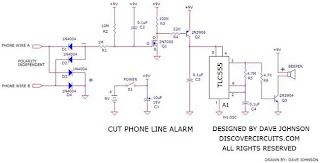A bridge rectifier front end makes the circuit phone line polarity independent. It shows four 1N4004 diodes being used but you can also use a standard low current bridge rectifier package with a 200v rating or more. The bridge is wired so the output voltage goes negative relative to circuit ground. The phone line will typically be somewhere around 30v when in standby mode and drop to something less than 15v when a phone is connected to the line. In the circuit, this translates a negative voltage fed to the gate of the 2N7000 FET, which kept the transistor turned off. When the phone line is cut, the voltage fed to the gate of the FET will swing to +9v, which will turn on the FET. When Q1 turns on, it also turns on Q2, which routes power to a 555 timer circuit. The 555 timer is wired as a 1Hz square wave oscillator, which drives the transistor Q3. That transistor drives an alarm beeper. With the components shown, the circuit draws nearly zero current in standby mode. Therefore a good quality 9v battery should last for many years.


